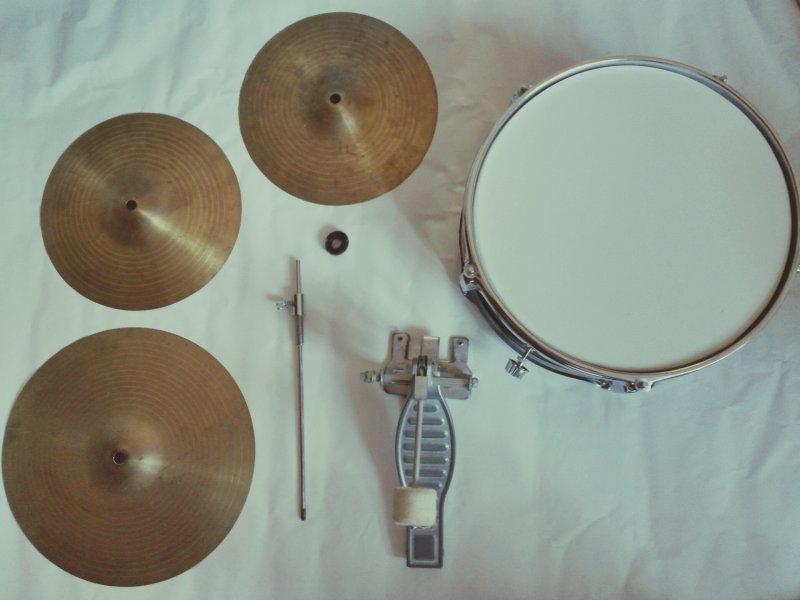As you’re learning drums you will acquire new gear like drum sticks, drum sets, and cymbals. It’s important to understand how drum equipment can influence your sound, and it’s helpful to have the appropriate information to make smart buying decisions. Here, Edmond, OK drum instructor Tracy D. gives you a crash course on cymbals…
Are you a drummer looking to add some variety and depth to your drumset? The answer might be as simple as adding new cymbals. From thin crash cymbals to heavier ride cymbals, there are plenty of options to choose from.
But with so many different types of cymbals available, it can be hard to decide which ones are right for you. To help you make the right decision, let’s take a look at the different types of cymbals available and how they can benefit your kit.
What Cymbals Should a Drummer Have?
Every drummer needs an arsenal of cymbals to produce a great sound. Choosing the right set for your style can be daunting, but with some research and a comprehensive understanding of what different shapes and materials can do for you, you can pick the best possible combination.
- There are three basic categories to consider: ride, hi-hat, and crash/splash.
- Ride cymbals are usually large and thick, allowing them to be heard clearly over drums and other instruments.
- Hi-hats are smaller and produce a lower pitch when struck against each other or a head.
- Crash cymbals have larger diameters that allow for greater volume and longer sustain.
Picking the type, size, material, weighting options, bell shape feature and construction is not only based on personal preference, but also what kind of style might best suit your playing abilities in order to create an expressive performance.
Not sure what to look for? Ask your drum teacher for tips! You’ll learn everything you need to know about which equipment you need – plus helpful tips like what you see in the video below:
https://www.youtube.com/watch?v=_6R2QeM3fBA
Everything You Need to Know About Cymbals for Drummers
Your cymbals make up a complex, beautiful mix of voices. As you develop, your ears will crave more nuance and depth from your instrument(s).
When it comes to cymbals, there are important things for you to consider like tonal color, size, finish, and application.
I will explain these factors and introduce you to brands to help you find the right cymbals to suit your needs.
Anatomy
- The raised center of the cymbal is the bell, and the bow is the area between the bell and the edge; you will use all of these surfaces when you play.
- Higher quality cymbals are made of bell bronze (an alloy of copper, tin, and silver) usually called B20.
- Entry-level cymbals are typically made of a B8 (92 percent copper, eight percent tin) alloy.
Sound
- Lathing produces the concentric circles on its body, and the width – or lack of, affects the sound.
- Hammering also affects sound by adding depth, dryness, and complexity.
- The finish (brilliant, natural, or raw/unlathed) will also affect the sound (brighter to darker) and tend to accentuate the following qualities: glassy or shimmering (brilliant), steamy or simmering (natural), or complex and dark (raw).
- The size and weight of the cymbals will affect the sound in terms of decay (the duration of time before the sound terminates) and volume.
- Smaller, thinner, and usually with a flatter bow = quick or fast-decaying. Larger, heavier, and usually with a pronounced bow = “washy” or long-decaying, and will produce higher volume. A cymbal that is very dry and quick may be described as “trashy”.
All of these variables influence the overall effect, and several different options make it possible to create a customized palette.
Cymbal Types and Applications
There are several different types of cymbals that make up an expressive set, and each has a different, sometimes overlapping use:
- Hi hats: Usually 13- 14 inches, have bark and bite. Hi hats keep the clock ticking; they have attitude and are tremendously expressive.
- Crashes: Anywhere from 14- 22 inches, they add drama, mark transitions, and act as the loud speakers. You will most likely want several of these.
• Splashes: Usually six – 12 inches, these are great for quieter passages or quick punches.
• Rides: Generally 20 to 22 inches, rides range from articulate to washy. They carry bridges and choruses. They are prominent voices in jazz, and the bell is used quite often.
• Effects: These come in all sizes and they can be Chinas, stacks, perforated, cup chimes, etc. They are your color instruments.
Now, let’s look at a few well-known brands. Remember, a cymbal series is like a family that plays well together.
Sabian
Sabian offers the B8 and B8 Pro series, among others. These are bright, entry-level cymbals.
Higher-quality cymbals in the brighter range include the AAX, AA, and Paragon series.
The darker series are the HH and HHX.
Zildjian
Zildjian’s entry-level lines include the ZBT and ZHT (bright).
Higher-quality brights include the A Custom, or the K Custom in the dark range.
Meinl
Meinl offers the MCS at the entry level (bright) and on the upper tier, the bright Byzance Brilliant.
The Byzance Dark speaks for itself.
Paiste
Paiste offers the PST (bright) and others, at the entry level, and the more refined Signature Precision on the brighter side.
The complex Signature Dark Energy rounds out the range.
While you can get a picture of a cymbal’s sound from online sources, nothing beats first-hand trials when making your selection. Consider how the cymbals will interact with your drum set, and know that the room will affect the sound, as well.
You may choose to stay within a specific series or mix it up a bit for a more customized sound. Either way, enjoy the process and have fun!
Tips for Finding the Perfect Cymbals for Drummers
No matter what type of drumming you are doing, choosing the right cymbals is an important part of creating the sound you want. From loud rock drumming to jazz and hand drumming, each genre requires its own unique set of cymbals.
What are the Best Cymbals for Loud Drummers?
For loud drumming, you need cymbals that can handle a lot of noise without getting distorted or over-saturated. Generally speaking, medium to heavy weight cymbals work best for this type of playing style as they can withstand more volume without breaking. Hi-hats typically range from 14” – 16” in size, while crash and ride cymbals range from 18” – 22” in size. Larger sizes will produce louder sounds with more projection and sustain, so choose accordingly based on the sound you are looking for.
What is the Best Ride Cymbal for Jazz Drummers?
When it comes to jazz drumming, a good ride cymbal is essential as it provides a steady pulse that keeps time in a jazz ensemble. A good ride should have plenty of stick definition and brightness but also have enough wash and sustain to fill out the groove.
Generally speaking, thin weight rides with a bright tone (like brass or bronze) tend to work best in jazz settings as they provide a crisp attack with plenty of sustain. A 20” ride is typically recommended as well as it has great projection but isn’t too large or overwhelming sounding.
What Cymbals Would You Recommend for Hand Drummers?
Hand drums require specific types of cymbals that are designed to produce warm tones without too much wash or decay. Thin weight bronze or brass models tend to work best for these styles as they create a bright attack but don’t overpower the other instruments in an ensemble setting. Smaller sizes (14” – 16”) are often recommended as well since larger sizes will create too much wash and mask other instruments in an acoustic setting.
What Cymbals Do Rock Drummers Use?
Rock drummers generally use a combination of several different types of cymbals to provide a full and exciting sound. Ride cymbals produce a sustained sound used for longer beats while
Hi-Hats create rhythmic patterns used in popular rock music.
Crash cymbals also add an energizing sound when needed, most notably during snare led fills. Some drummers opt to use effect cymbals such as splashes or Chinas that produce unique sounds for special effects or accents. Whatever combination of cymbals drummers choose, they are essential for providing the powerful full sound associated with rock music.
How Many Cymbals Should a Drummer Have?
A drum set typically includes several cymbals of various sizes, the most essential of which is the hi-hat. Hi-hats come in pairs for a standard setup, and one additional cymbal is usually included (either a crash or ride), with an optional fourth being a splash — all of which can help add complexity to a beat.
With these four cymbals alone, any drummer can think outside of the box in terms of understanding how different combinations can create new rhythmic possibilities.
Beyond those basics, it’s up to personal preference depending on playing style and genre; some may prefer multiple crashes and rides, while others might opt for additional splashes or maybe even exotic models like gongs and chinas.
What are the best cymbals for drummers? Ultimately, when building their kit or considering purchasing additional pieces, every drummer should try what feels best for them both musically and physically.
What type of cymbals have you tried? What did you like about them? Let us know in the comments below!
Get started with your drum lessons today, find a drum teacher near you!
Photo by j_arlecchino
 Post Author: Tracy D.
Post Author: Tracy D.Tracy D. teaches percussion and drum lessons in Edmond, OK, as well as online. She has been playing the drums with various bands for more than 13 years. Tracy earned her Bachelor’s in Music Education from Oklahoma Christian University and has played with the OKC Community Orchestra since 2009. Learn more about Tracy here!
Maile Proctor

